December Newsletter
Volume 1, Issue 10
December 1, 2020
Special Points of interest

State Director of Instruction
Welcome to the December issue of the MRC newsletter. We hope all of you and your family and friends are staying safe.
Many of you have already finished your recertification process. We have a lot of recertification clinics scheduled for December. So please visit our website to start the recertification process. You can find the recert information here.
November marked the beginning of the Referee Mentor Development Program Cohort #3. As you may remember from previous newsletters, two groups of referee mentors went through a virtual training over spring and summer this year. The training for these two groups of mentors ended in September. Along with other mentor candidates, those who participated in the development program earlier are currently going through the U.S. Soccer Referee Mentor certification process to officially become mentors in Spring 2021. The third cohort of trainees are those who are not instructors or assessors yet. But they may mentor referees locally or are interested in becoming a U.S. Soccer mentor in the future. They will have online monthly trainings for six months. After successfully completing the training program, they will be invited to take the U.S. Soccer mentor certification class. Below, you will find an article by Jeremy Wittrock, one of the mentor candidates.
We also have our second mentor workshop. These monthly mentor workshops provide mentors with opportunities to deepen their understanding of the Laws of the Game and FIFA Considerations. In October, the workshop focused on offside, particularly interfering with an opponent. In November, we focused on the illegal use of arm. These 90-min sessions are interactive and help mentors familiarize themselves with how the Laws and Considerations are expected to be applied.
As always, our December newsletter is full of exciting stories and information. We are featuring John Corbett as the MRC member of the month. Our regular content includes Referees of the Month and Who’s Who. We are featuring Joey Knoff as the Referees of the Month, and Jim DeBrabander for Who’s Who. As was mentioned last month, Nichole Kramer-Kiuchi has started her referee coach certification class with U.S. Soccer. She is going to share the recap of her first session in her article. Ken Wikle has an article about assistant referees. Nick Balcer also talks about the importance of report writing.
https://twitter.com/michiganrefereeBeyond this newsletter, please be sure to follow our Twitter (@MichiganReferee) and subscribe to our YouTube Channel.
Inside this issue
- Corbett Interview
- What’s in a Name?
- Referee of the Month: Joey Knoff
- What is Your Call?
- Referee Coach Class
- What Does Refereeing Mean to You?
- Referee Mentor Development Program
- Assessing the Severity of an Offence: Part 6
- Who’s Who: Jim DeBrabander
- Assistant Referee Chronicles
- Message from Marilou, Lynn, and Julie Tobin, OSI
Michigan Referee Committee: John Corbett
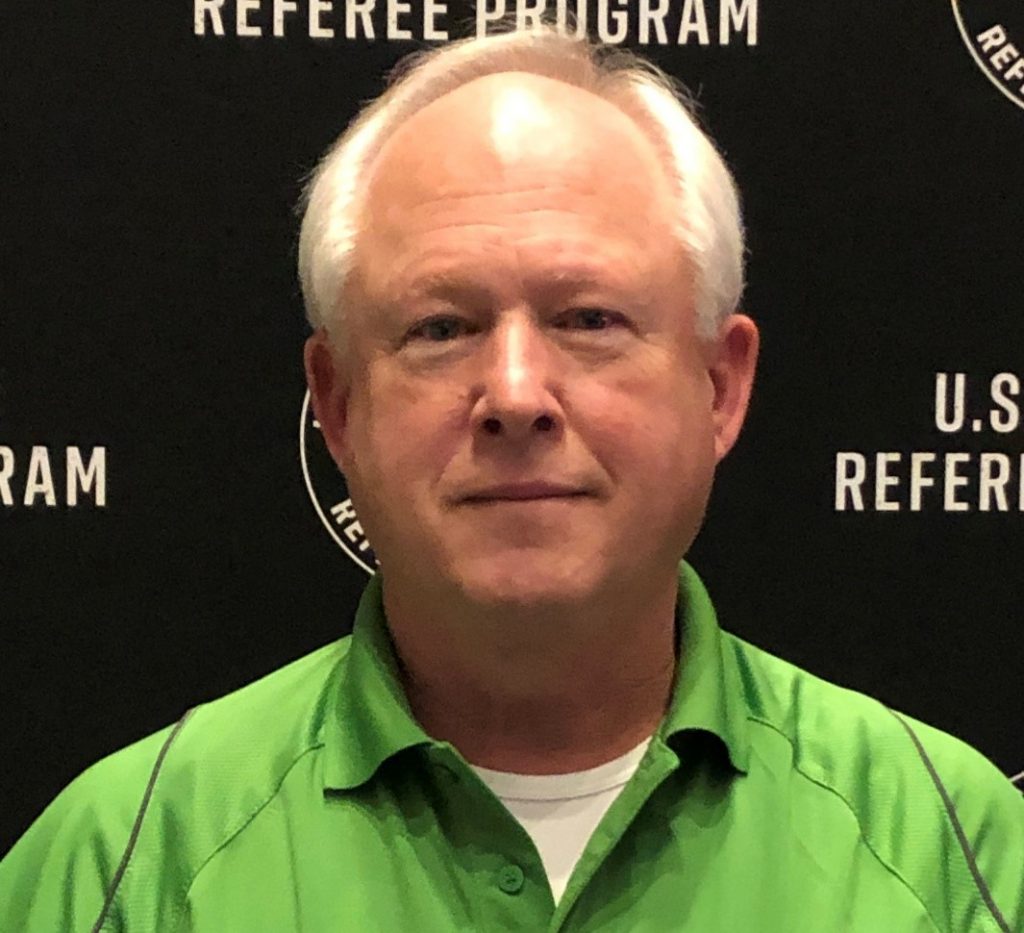
State Director of Assignors
For the November newsletter, we interviewed our State Director of Assignors (SDoA), John Corbett.
When and how did you become the SDoA of Michigan?
In 2015, I became the State Director of Assignors after interviews with Carlos Folino (SRA) and Francisco Villarruel (SYRA). The interviews were difficult because instead of asking specific questions that gave direction and boundaries to my answers, they simply asked “why do you want to be the SDoA?” It was up to me to decide where to start and how much to say. In retrospect, I believe that was the best challenge to lead with. Most of being the SDoA is what I bring to the referee and assignor community- not the mechanics of being the SDoA. There is no structure to hide behind. It is up to me to make my services relevant to the assignors I serve and the referees all assignors serve.
How were you involved in Michigan soccer before you became the SDoA?
I have 3 daughters who played select and premier soccer. I was the team manager for their teams simultaneously. That was my first serious introduction to playing soccer, as I have never played on a soccer team. I was (and continue to be) involved in Michigan soccer at the ground level. I helped create and organize the Grand Valley Soccer Officials Association (GVSOA). I am an administrator with the association. I meet with club administrators, team officials, and parent groups to explain law changes and answer their general questions (not questions about specific prior decisions by a referee).
My first contact with the USSF and MRC occurred in 1996 when I complained about referees not showing at games (and perhaps a call or two…). I accepted the challenge to become a USSF referee. When I got to the first class, I found the person I complained to was the class instructor. After assigning for a club for three seasons, I became certified assignor with the USSF. A short time later I was asked to teach USSF assignor certification classes to new assignors. I am a regional premier assignor as well. I cross-certified with AYSO as a regional referee. Concurrently I upgraded from 8 to 7. The following month, after a game, I was invited to apply to become an assessor. I did apply and became a USSF assessor. Within 2 years, I was invited to mentor training to become a USSF mentor. I completed training and in turn trained other referees to mentor. The local league accepted my presentation to pay mentors game fees for mentoring because it took them away from games and money. I am a member of the Grand Valley Soccer Association board as the GVSOA referee representative. I have been a referee instructor for many years. I enjoy the challenge and face-to-face connection with the people in classes. I taught referee classes to middle school students who wanted to work their school’s recreational soccer games.
What are your major responsibilities as the SDoA?
I have two major responsibilities: keep the certification and recertification materials current, and be available to assignors to support and assist assignors, troubleshoot for them, and certify new assignors. In order to accomplish these, I keep open communication with the assignors on what they need to excel in their work, and what hinders their efforts. And then deliver what they need to excel.
What do you enjoy the most about being the SDoA?
I work with a group of people who are supportive and push me to improve what we do and how we accomplish our goals.
What is your referee background? When did you start refereeing?
I became a grade 8 referee in 1996. I upgraded to grade 7, and cross-certified with AYSO as a regional referee. I have worked in recreation leagues at all age levels, select league games, premier games, Super Y games, State Cup games and a semi-pro game. In retrospect, and with some embarrassment, I believe I have made almost all the game mistakes a referee can make. And for that reason, also believe I have a link with referees I teach/mentor when we discuss errors a referee can make (and survive!).
What is the best memory of being a referee?
Actually, it is a collection of memories. I never played soccer. Younger referees and more experienced referees worked with me during (and between) games during my first three seasons how to apply the LOTG. During a class, my instructor commented the LOTG are not published in hard cover. These referees taught me why. Without their help I don’t believe I would have found personal achievement in working games or received upper level assignments.
What makes a good assignor?
Surprisingly, it is the responsiveness of the assignor to the referees, teams, and clubs he/she assigns for that is the most important. Secondly, it is knowing where to find the answers and presenting them. Rarely are all games played with full crews as originally scheduled. Timely responsiveness resolves many issues and reduces the temperature on the remaining ones.
What can referees do to help assignors?
At the most basic level, keep their availability current and accept assignments as received that match their availability. Each time they can accept assignments outside their availability, or give a substitute’s name who can cover a turned back assignment are greatly appreciated by the assignor.
Besides being the SDoA, what other roles do you have in the soccer world?
In addition to the roles previously mentioned, I am a back-up assignor for State Cup games. My relationships with referees frequently extend outside soccer, but only exist because of soccer. I am often asked (and agree) to write letters of recommendation to current and past referees for job applications, college applications, and applications to the Air Force Academy. At the request of the referee, I have verified game assignments and performance for federal background checks.
What advice do you have for young aspiring referees?
Decide which levels of competition you would like to receive game assignments, and work for them. Ask assignors, experienced referees, and others what you need to accomplish in order to be recommended to receive assignments leading to your goals. Ask more experienced referees to give you feedback on your pre-game, game, and post-game behaviors. Realize you are your best advocate. No one expects you to be perfect; but part of your progression includes making fewer mistakes. Do not forget as you progress in game assignments, you are expected to give back to the game. Accepting less competitive assignments, giving constructive feedback to referees and assignors, are ways you can help others follow in your footsteps. Just as you are following those that preceded you.
Thank you, John.
Thank you.
What’s in a Name?
When you talk about refereeing, how careful are you about the words you use? Have you caught yourself or others say, “side lines,” “end lines,” or “box”? Have you corrected yourself or others to say “touch lines,” “goal lines,” and “penalty area’? A more experienced referee or mentor might have corrected your terminology. Why is it important that we use the correct terminology?
First and foremost, just like we apply the Laws of the Game, we apply the words and expressions used in the Laws of the Game. As will be mentioned below, the IFAB, the organization in charge of drafting the Laws, choose certain words with a particular intent. Therefore, deviating from words used in the Law book is similar to deviating from the Laws.
Knowing the correct words also showcase your understanding of the latest Laws of the Game. It was not too many years ago that we were careful not to say, “handball.” But if you look at the Law book today, “handball” is an expression you can find. Both “handling” and “handball” appear in the Law book. How many of you say, “PI,” short for “persistent infraction” as a reason for a yellow card? Have you looked at the Law book recently? If you have, you will notice that “persistent infraction” is not a part of Law 12 anymore. It is called “persistent offense.”
Top-level officials frequently debate the meaning of a word. Law 11, as a reason for an offside offense, mentions impact. How does an action that has an impact on an opponent different from an action that has an influence on an opponent? Why is the word “likelihood” used to discuss a tactical foul but not “possibility” or “potential”? This is the level of details that these top officials consider to make decisions.
“They will understand what I meant,” you might say. But how much do you trust a mechanic who does not know the name of car engine parts or a surgeon who does not know the name of body parts?
Referee of the Month: Joey Knoff
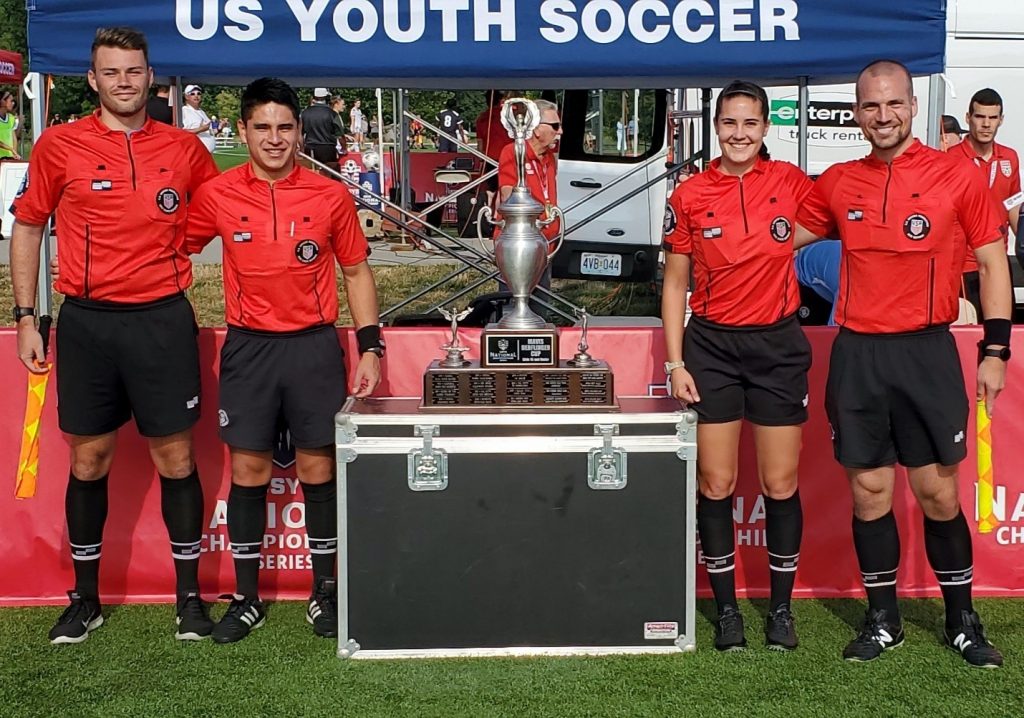
I started refereeing when I was 13 years old. I was just refereeing local recreational games at the Midland Soccer Club. At the time I was playing travel soccer on a team coached by Rob Camilletti, who was and is a well-known ref in the area. He encouraged all of us to become referees so we could gain a better understanding of the game and so we would learn to respect referees. I remember my first game as a referee being absolutely terrifying. It was a U7 match and there was only one referee on the game. My dad was there to watch and make sure things went smoothly (and drive me of course). While I’m sure the game went fine, I cried most of the way home, repeating to my dad that I didn’t know if I could keep reffing. He tried to calm me and encouraged me to try it again the next weekend on my games as an assistant referee on a U10 match. Seeing as I’m still a referee, that match must have gone much better than my first.
Fast forward about seven years; I was lining up before one of my college matches and Ron Grobbel was an AR. I asked him about how I could get involved with State Cup soccer and after following up with him the next day, I got my first invitation to a State Cup weekend. After a couple years of work, I was invited to my first US Youth Regional event in 2017. I was asked back to Youth Regionals in 2018 and 2019, and both years I was selected to represent the Region at the US Youth National Championships as an AR.
I’ve been a referee for over ten years and it wasn’t until my first trip to US Youth Nationals that I realized that I wanted to go AR track with my referee future. I’ve spent time watching people like Adrienne McDonald and Nick Balcer work their way through the ranks of refereeing, from youth, to semi-pro men’s, to professional matches. Through the US Youth Soccer Referee program, I’ve had the fortune to learn from the very best referees in the country, with their continued mentorship I aspire to follow in the footsteps of Adrienne and Nick.
COVID-19 has affected all of us and it has put plans and aspirations on hold for a lot of us, but we will come out of this stronger, faster, and more knowledgeable than we were in 2019. Following the advice my dad gave me as a teenager at the start of my referee career, remember to stick with it- the days are brighter on the other side.
What is Your Call?
In November, we started this new series. You were given a video clip and were asked to submit your call. More people than expected submitted their answers.
The November video was this.
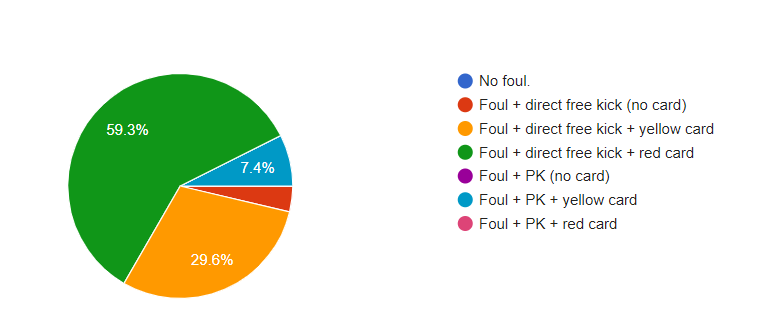
As you can see, out of 25+ respondents, about 60% of you said the play should be penalized as a foul with a direct free kick and a red card. This was the correct decision. The replay footage from the goal line camera shows a clear tripping offense by the red player. The footage also shows that the contact happened outside the penalty area, even though the player fell inside the penalty area. At the moment of the foul, the white attacker had a likelihood to control the ball, was near the goal (i.e. just outside the penalty area), was moving toward the goal, and only had the opposing goal keeper left in front of him. Therefore, this was a denial of an obvious a goal scoring opportunity.
If the foul had happened inside the penalty area, because the red player’s slide tackle was a legitimate attempt to play the ball, the red card would have been downgraded to a yellow card, with a penalty kick.
The December video can be found here.
You can submit your answer here
Referee Coach Class: Overview

Manager of Video Analysis and Referee Coach Candidate
Hello, everyone I’m Nichole Kramer-Kiuchi and, as announced last month, I am one of the newest additions to the Michigan Referee Committee, filling the Manager of Video Analysis role. While 2020 has been a challenging year, it has allowed the MRC to restructure according to the new pathways that the U.S. Soccer had established, and I’m excited to have the opportunity to work with the other managers, Tim and Jeff, to help provide instructional content for our referees and referee mentors!
In addition to this manager role, I was also selected by U.S. Soccer to go through a virtual training session with 15 others from numerous states to become a Referee Coach. As many of you know, U.S. Soccer restructured its referee certification process. Instead of having Grades 9 through 3, we now have Grassroots, Regional, and National referees. They did something similar on the instruction and assessment side of refereeing, combining the two areas into one certification. Now instead of instructors and assessors, we have Referee Mentors, Referee Coaches, and National Referee Coaches.
Referee mentors will be focused primarily on Grassroots referees, leading video analysis sessions, observing performance of Grassroot Referees, and leading field sessions. Referee Coaches will coach Grassroot and Regional officials, and responsible for five tasks: leading video analysis sessions, evaluating performance of match officials, leading and facilitating post-game team reflection, writing the feedback and evaluation of performance, and leading field sessions.
The Referee Coach course consists of four webinars lead by current National Referee Coaches and includes assignments to review and practice the five tasks of a Referee Coach. These webinars are taking place this year. A second part of the course will include practical assignments to be shadowed and evaluated by National Referee Coaches, running through June, 2021. It is a long process but once finished I’ll be the first in the State to have completed the course earning the Referee Coach title.
I will be using the instruction passed down in this course to help in my new role as Manager of Video Analysis and I’ll be sharing some of the things I’ve learned with our Michigan Referee Community in hopes of providing some background for the newer instruction you will see coming from the MRC. Next month, I will follow up this article with the first task of a referee coach, conducting video analysis.
What Does Refereeing Mean to You?
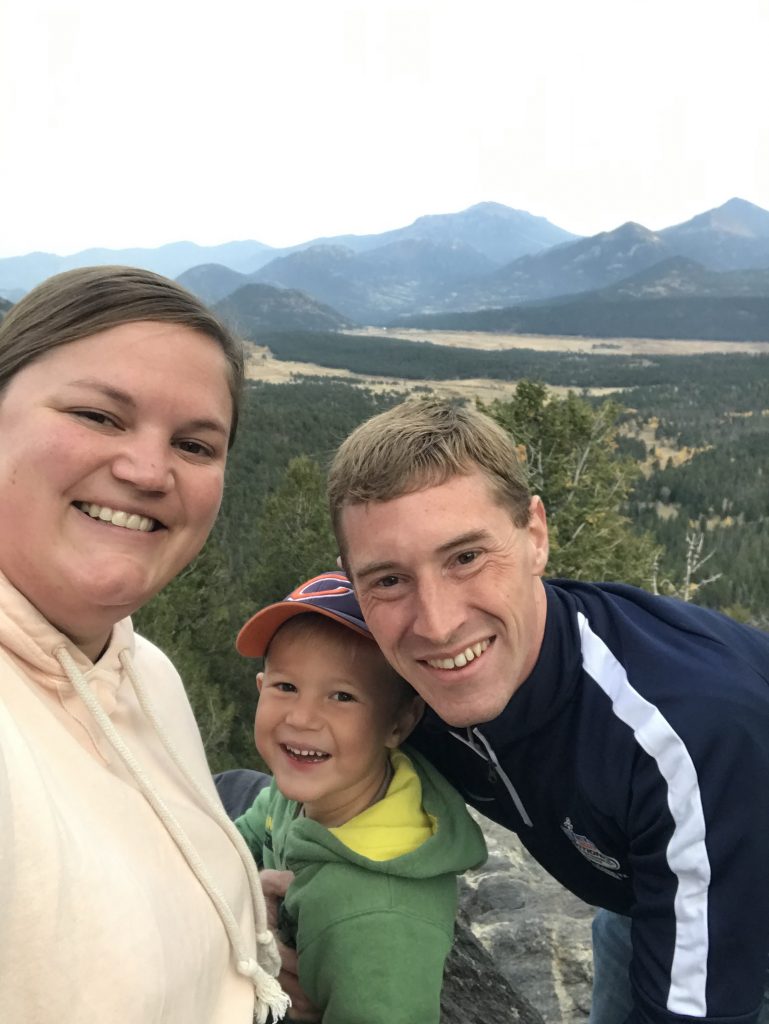
Regional Referee
As I sit here and reflect on how to tell you who I am with a focus of refereeing, I find it difficult to really convey all that “refereeing” means to me. So I’ll tell you a little about me, but also would encourage you to reflect. As a reader of this article, you are more than likely a referee yourself. Some key words come to my mind as I reflect upon my own refereeing life: Friends. Family. Dedication. Hard work. Sport. Achieving. Striving.
Friends + Family: At some point in your refereeing journey, these words really begin to mean the same thing. Friends I have met through refereeing are family to me. And they are family to my family as well. The relationships you build will survive time and distance. I know that I can count on any fellow referee in a time of need and they can count on me.
Dedication: At the age of 12, I started refereeing by being “volun-told” by my mom that I would referee for our local AYSO region to help out. I have stayed involved with AYSO through the present day. Those roots led me into helping referee local homeschool programs, which in turn led to doing high school, and in turn led me into starting USSF refereeing in 2012 while living in Chicagoland. I enjoy giving back to my local community, helping others enjoy soccer where they may not otherwise get an opportunity. Do you have dedication to your pursuits?
Hard work: If you have ever refereed a single match, you know the challenges. It isn’t easy. And it wouldn’t be worth doing if it was. I never was the most fit or athletic person, and still am not! But by pushing myself to be better each game, one of those areas is physical fitness. Getting up at 6am every day to go for that run is no fun at all, but hard work pays off. Maybe for you it is getting in and studying the laws. Maybe it is taking that extra game to help an assignor out, or making that last extra effort run late into a State Cup match to ensure you don’t miss a thing. Work hard, and do your best, it pays off.
Sport: I love soccer. The fluidness. The fans. The culture. The grey areas. The speed. The athleticism. The history. There is so much more to it than 22 players kicking a ball around for 90 minutes. Where else can you get the best seat in the house, helping orchestrate it all for everyone’s enjoyment? When you get the satisfaction of a perfectly played advantage leading to a goal. When you see the smile on the 10-year-old who just scored their first goal. What can be better than a sport that can prompt so many feelings and emotions in the course of 90 minutes?
Achieving: I have had the privilege of refereeing in various regional, state, and national competitions and tournament finals. When you get that assignment and realize your hard work, dedication, love for the game and pursuit of it has finally paid off. Savor the moment and enjoy it. Then set the next goal to achieve.
Striving: Always strive to do your best. In every match, in every situation, on and off the field. As a referee, strive for that perfect game. I guarantee you will always find something you can improve or wish you would have changed. Go back and play it back, figure out what you could do differently the next time. There will be a next time. Be ready.
Referee Development Program
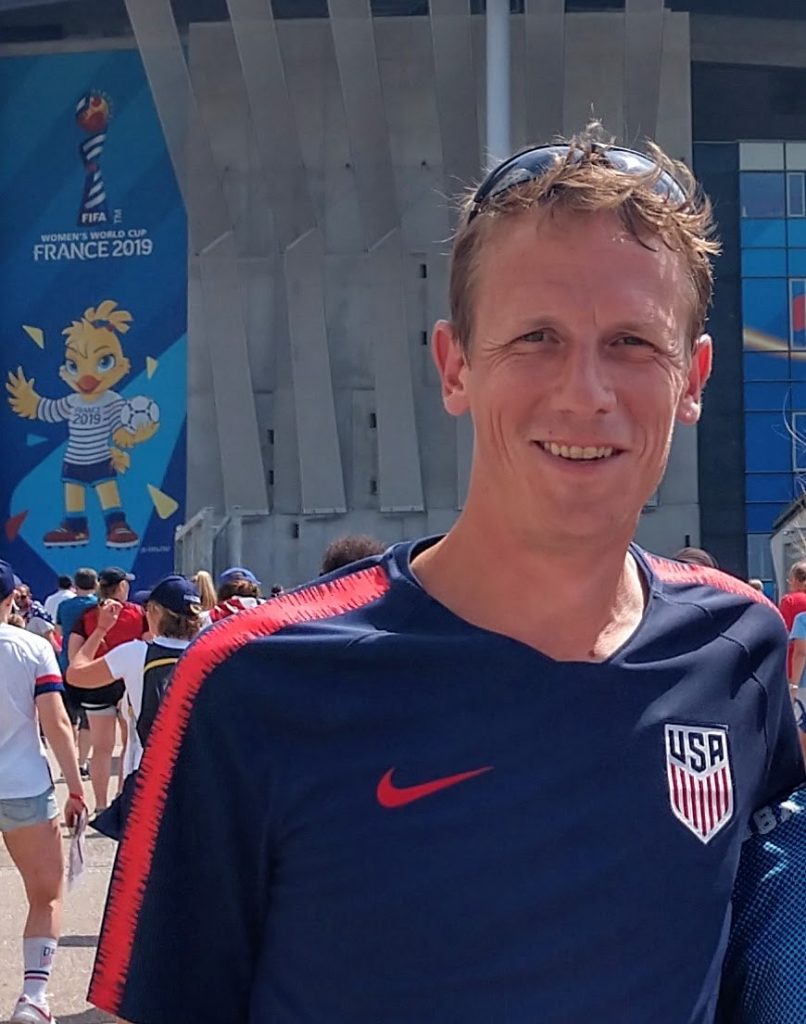
Referee Mentor Candidate
The Michigan Referee Committee recently invited me to be a part of a 6-month long referee mentor development program, and I was thrilled to accept the offer.
We had our first session last month, which was led by Nichole Kramer-Kiuchi. We learned more about the role of the referee mentor during the first part of the meeting and the required skills to be effective referee mentors.
The primary topic of the training session was leading video analysis to help with referee instruction and development.
Almost all of us have attended a training session where video clips are presented and discussed. Personally, I find these sessions the most effective method (outside of direct experience) to learn how to accurately apply the laws of the game. However, many of us don’t think about the time and preparation that is needed to present these clips well.
Nichole opened our session by showing a video clip and asking each of us for our decision. After hearing our input, Nichole walked through the clip with us and explained the correct decision using the Laws of the Game.
After this intro, Nichole guided us through the effective presentation & engagement around video clips, and how to utilize them effectively based on various audiences. Ultimately, we learned what is useful information to present and how to present that information. She also directed us to a resource library of clip from US Soccer & the Michigan Referee Committee.
Last month’s meeting was my first step toward becoming a referee mentor, and I am excited to continue with the course and have the opportunity next month to deliver a presentation on a video clip of my own.
Assessing the Severity of an Offense: Part 6 (Tying Considerations Together)
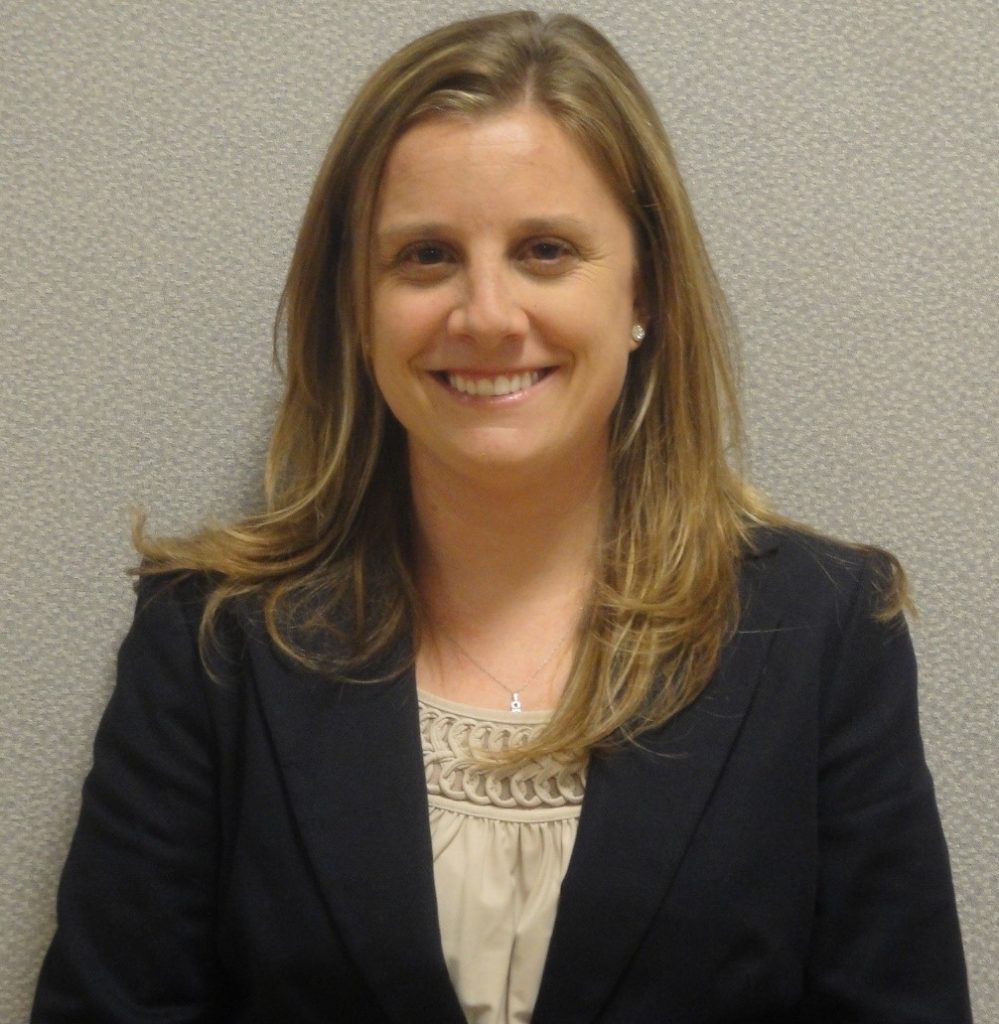
National Referee Candidate
Last month, we introduced the concept of direction as a consideration for determining foul severity. Let’s review the example clips:
The expected decision on this play is no foul. Contact is initiated by the attacker. The defender actually pulls his leg out of the way in an attempt to avoid making contact.
The expected decision on this play is no foul. Attempting to play the ball does not necessarily mean the player must touch the ball. We can give the benefit of the doubt to the goalkeeper. Both players are attempting to challenge for the ball, the contact occurs from the front, and the attacker’s likelihood of keeping or gaining control is very poor due to the high bouncing ball and contact occurring so close to the goal line.
Let’s recap and review all of the considerations we have discussed for determining the severity of a foul. As the detailed explanations have shown, we can think about these on a scale:
1, Point of contact of the perpetrator and point of contact of the victim;
2, Speed + Distance = Force;
3, Timing: early, with the ball, late; and
4, Direction: front, side, or behind.
| Low Severity Foul Contact is generally: | Medium Severity Foul & Yellow Contact is generally: | High Severity Foul + Red Contact is generally: |
| Lower on a player’s body. From a player initiating contact at slower speed and players are close to each other. At the same moment as an attempt to play the ball. From the front and the receiving player can see the opponent. | Lower on a player’s leg or torso/shoulders. From a player initiating contact at mid-level speed and distance. Within a very close window of time as an attempt to play the ball. From the side and the receiving player has an awareness of their opponent and challenge. | Higher on a player’s leg or head/neck. From a player initiating contact with high speed and great distance to travel to get to the opponent. Significant amount of time before or after an attempt to play the ball. From behind and the receiving player may not be aware of the impending contact. |
There is not one consideration that is more important or deserves higher priority than the others. We should take all four points into consideration on every foul decision. Not one consideration on its own should cause us to move the foul into a higher level of severity. However, sometimes there may be one consideration on its own that will cause us to move our decision into a lower severity. If we determine that a challenge warrants a red card, we absolutely want the criteria to be met. If you are in doubt, it is better to “go low” and penalize with the lesser serve option of the two that you may be considering.
Counting to practice processing these four considerations as you review clips and watch games on TV, so that when you are on the field, it is routine in your mind and you are comfortable evaluating the considerations at game speed.
Who’s Who in Michigan: Jim DeBrabander

USSF Instructor and Assessor
In 2002, I met my future wife playing miniature golf online (yes, that was a thing). The emails became phone calls, the phone calls became visits, and eventually, we started talking about marriage. However, she lived in London, England; and I was located in Marshall, Michigan. So, we had some things to work out. Eventually, she made the brave and difficult decision to leave everything she knew behind and move here with her two young sons. Her one requirement? I had to find a football program for the boys. Fortunately, I knew enough to know she meant real football, not the American sport played with hands!!
Not knowing much about soccer in the area, I turned to the Internet and found Marshall had an active AYSO program for their ages. I got in contact with them and was able to sign the boys up. Nicola and I were married in early 2003 and the boys started with AYSO that spring. On their first day of practice, my wife took the boys to the soccer field and introduced them and herself to the coach, who also happened to be the AYSO Regional Commissioner. Upon hearing her accent, he says; “Oh, you’re from England? You must know soccer. You’re going to be my assistant coach!” (Side note: Nicola knew very little about soccer at that point). Thankfully, she took on the task, bought some soccer books, and started to learn.
After a couple of weeks of practice, she came home one day and announced the Region needed referees and she signed us up to take the referee class the next Saturday. We sat in an all-day class, completed the requirements, and became AYSO Regional Referees (equivalent of a USSF Grade 8). One week later, I was assigned to my first game, U-16 Boys, as the center referee. Oh, and with no ARs! Thankfully, I knew what to do in this situation, and I gave each coach a flag and got two club linesmen. Somehow, I survived and didn’t mess up too badly. To my surprise, I ended up enjoying it and started refereeing multiple games every Saturday morning, and got better with every game I accepted.
I started getting to know the AYSO program and found out they had other levels of referee training. This led to me making some friends in the referee community, who eventually ended up mentoring me and helping me grow as a referee. Eventually, my wife and I found out about “travel soccer” (USSF club soccer), and signed our boys up to play. By this time, I had advanced to an AYSO Advanced Referee and was now the Regional Referee Administrator for Marshall’s AYSO program. Within the AYSO program, I went on to become a National Referee, National Assessor, and I’m working to become a National Instructor. I eventually became the AYSO Section Referee Administrator for Michigan, Indiana, and Ohio (though mostly Michigan, as the other areas had very few programs).
Money was tight, so I found out I could cross-certify from AYSO to USSF and pick up some games that paid (AYSO is a volunteer organization). Initially, my focus was just to earn some gas money, and I would pick up a game or two wherever the boys were travelling to play. With my AYSO training and experience, I quickly moved on to more challenging matches, made many more contacts, and was able to duplicate much of my success from AYSO onto the USSF side of things. Just like with AYSO, I became an instructor, assessor, and administrator. I also achieved Grade 6 certification and eventually managed to get certified for high school and college matches, as well.
My favorite refereeing memory actually occurred off the pitch. The AYSO National Referee course is a 3-day class that is taught by some of the best instructors in the country (including FIFA referees as guest instructors). Michigan would collaborate with the Illinois section and host a course every two years, alternating locations. In 2006 one of my early mentors, Jim Dyer, and I were invited to attend the course in Chicago. The second day of the class, we took a break to watch the Italy vs France World Cup final. Imagine the reaction of about 20 referees watching the events of Zidane’s head-butt play out during an epic match!
These days, I still enjoy the thrill of the game and getting out to referee. But just as much, I also enjoy helping new and less experienced referees improve. Since becoming a referee instructor, I especially enjoy teaching the Grade 9 and now the Grassroots referee classes. I love sharing my passion for learning with these new students. As I start to referee less, I hope to teach, assess, and mentor more. My biggest advice to new referees is to simply do more games, find some good mentors, and give AYSO a try. They may not pay, but the experience you gain is worth the time and effort.
When I am not on the soccer field or working as an engineer, I enjoy golf, bowling, Jeopardy, cooking and spending time with family and friends. As a Liverpool FC fan, I try to watch as many of their games as possible!
Finally, to end this full circle, I really need to thank my biggest supporter in this adventure, my wife Nicola. She got me started on this journey, and has been there every step of the way, encouraging me and tolerating all of the time spent away from home. Without her support, none of this would have been possible. I would be remiss not to also thank the rest of my family, my six wonderful children. At some point, everyone in the family has been certified to referee either with AYSO or USSF, with a couple of kids even advancing onto high school and college refereeing! They spent many weekends being trekked around soccer fields, various tournaments, and refereeing conferences with us. I would also like to thank the many referee friends and mentors in both AYSO and USSF who have helped me along the way.
Assistant Referee Chronicles: Part 2

Regional referee first registered with USSF in 1978
In order to call offside and judge balls over the touchline and goal line, the AR has to discipline themselves to be in the best location to observe the ball in relationship to the line in question. For offside, the assistant referee must be precisely position themselves even with the next to the last defender or the ball whichever is closer to the goal line.
An AR should be a yard off the touchline as he/she runs up and down the field. This gives the best view for judging the ball over the touchline.
In amateur and youth soccer, having enough room on the touchline can be a problem. Spectators and coaches want to be up too close to the line. As part of the officiating team, you are responsible for the safety of the players. Spectators in lawn chairs too close to the touchline present a safety issue if they are too close. If they are on the touchline, they may obstruct the AR’s view or be in his way as they try to run. An AR needs to keep their eyes on the field constantly. Switching their gaze from the field to coaches, spectators, or substitutes is a distraction that may cause the AR to miss a call.
Before the game starts, go over to the touchline and inspect how close spectators are seated. Move them back politely so you have room to run and see the touchline the entire length of the field and you won’t have to run on the line or inside the field to do your job.
The top priority for the AR is calling offside in the half of the field for which they are responsible. Signaling for a player who is to be called offside is accomplished by stopping, standing at attention, and raising the flag straight up in the right hand, and waiting for the referee’s whistle or alternately for the referee to wave the AR down.
Making an accurate offside call is a matter of correct positioning, concentration, and a thorough understanding of Law 11. The most important element in correct positioning is staying exactly even with the second to last defender or the ball as play occurs.
Being a yard off either behind or ahead of exactly even can cause the AR to make an incorrect decision due to a visual phenomenon called parallax. Two players who are exactly even (which is onside) will appear uneven from an angle due to parallax. To make an accurate offside determination, the AR must view the opponents directly even with them along the touchline. While this situation may not come into play when a player is two yards or more offside, as players get faster and more adept at making runs on goal they will be “dead even” with the next to the last defender when their team mate touches the ball in their direction. A properly positioned AR is the only way a correct offside call can be determined.
New ARs have the most trouble staying even with the second to last defender. The tendency to “game watch” when there is not an immediate attack in their end causes them to lose their position (even with the second to last defender) and if the ball is kicked quickly forward they lose the call. Game watching in other situations even in their end can lead to the same result.
An AR needs to keep in mind that concentrating on the position of attackers in relationship to the second to last defender is their top priority. Even when the ball is close to the AR’s touchline threatening to go out of play, the AR must be able to anticipate an offside call if the ball is kicked forward. This creates one of the most challenging situations for an AR, even one who is correctly positioned and concentrating well. In the final analysis missing a throw in call would be less critical to the game than missing an offside call that led to a goal.
One method of mechanics that helps performing the job of an AR is sidestepping. Sidestepping allows an AR the ability to use their peripheral vision to see more of the field while moving. Turning and sprinting immediately takes a good part of the field over the AR’s shoulder out of view. A ball near the touchline over the AR’s shoulder may go out unobserved if he/she is turned sprinting. A player behind an AR while turned and sprinting may commit a foul or a serious misconduct. If the referee is watching the attack, they may not see this either. The result is neither official sees the incident and it is totally missed. This may result in serious subsequent misconduct. Sidestepping is a skill that needs to be practiced and developed as part of an AR’s regular skills as well as using peripheral vision to see as much of the field as possible.
Running (sprinting) a ball to the goal line is another habit ARs must develop. A ball hanging on the goal line cannot be properly judged from 20 yards up field! A corner kick or goal kick signal made by an AR 20 yards up field does not sell the call especially if the ball hung on the goal line first. Even if the AR cannot sprint as fast as the ball travels (Who can?) sprinting to within a yard of the goal line for a corner kick or goal kick visually sells the decision even if the AR arrives there after the ball has left the field.
A situation that makes running to the goal line with the ball especially important is when the ball is between the goal posts. Judging whether the ball has completely crossed the goal line inside the goal is a critical game event. The ball may completely cross the goal line and reenter the field either in the hands of the goalkeeper or from a rebound off the cross bar or goalpost. A well-positioned AR is our only hope. The referee may be 20 yards up field and he will look to his AR for help. If the AR stopped running towards the goal line when the ball was kicked, they may be of no help to the referee. Sprinting to the goal line is the only hope grassroots referees have to make this call. The worst thing that can happen to your game is to not award a good goal because the officiating crew is not positioned correctly for a goal.
Message from Marilou, Lynn, and Julie Tobin

As many of you may be aware, Official Sports International has the annual holiday sale happening right now. They sent us the following message: “Hello to all of our Michigan Referee Friends! We wish you a happy & healthy Holiday Season and we look forward to seeing you all back out on the pitch in 2021!”
To take advantage of the holiday sale, please visit the following links.
Now is the best time of the year to buy the OFFICIAL U.S. Soccer referee uniform! Buy 2 or more jerseys & save! Mix Pro & Economy Styles. The Official U.S. Soccer Referee shorts & socks are also on sale! Shop Holiday Sale here.
New: Mix & Match our most popular training items & Save! Choose t-shirts, shorts or pants, ¼ Zips or Jacket. Pick 3 items and save 20%! Shop here.
Michigan Referee Committee
State Referee Administrator (SRA): Carlos Folino
State Referee Chairman (SRC): James Wheeler
State Youth Referee Administrator (SYRA): Ronald Grobbel
State Director of Referee Development (SDRD): Yuya Kiuchi
State Director of Assignors (SDoA): John Corbett
State Director of Futsal (SDF): Richard Gilbert
Email addresses are the title in parenthesis plus @michiganrefs.org
Please reach out to us!
If you have any referee-related stories to share or someone you think should be featured in this newsletter, please reach out to us at sdi@michiganrefs.org.
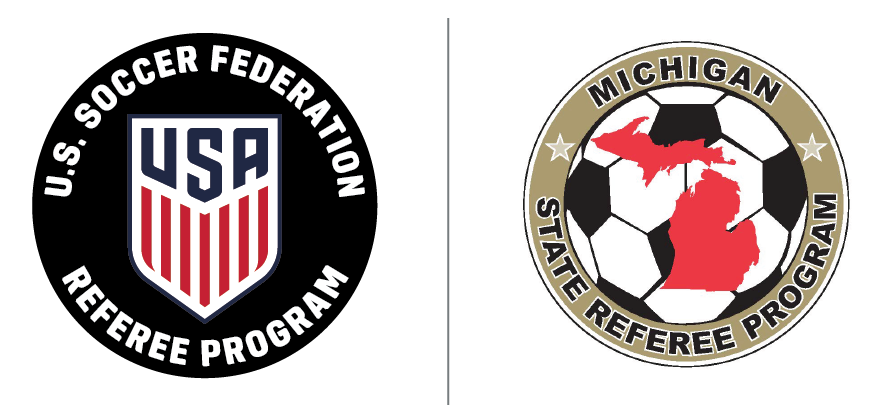
MRC announcements
We are in the middle of the recertification process. We hope you will take a recertification class soon so that you will be able to officiate in 2021. You can find the recert information here. If you know anyone who would like to become a referee, we offer numerous grassroots referee classes, as well. You can find relevant information here.
Contact one of us on the Michigan Referee Committee if you have any questions.


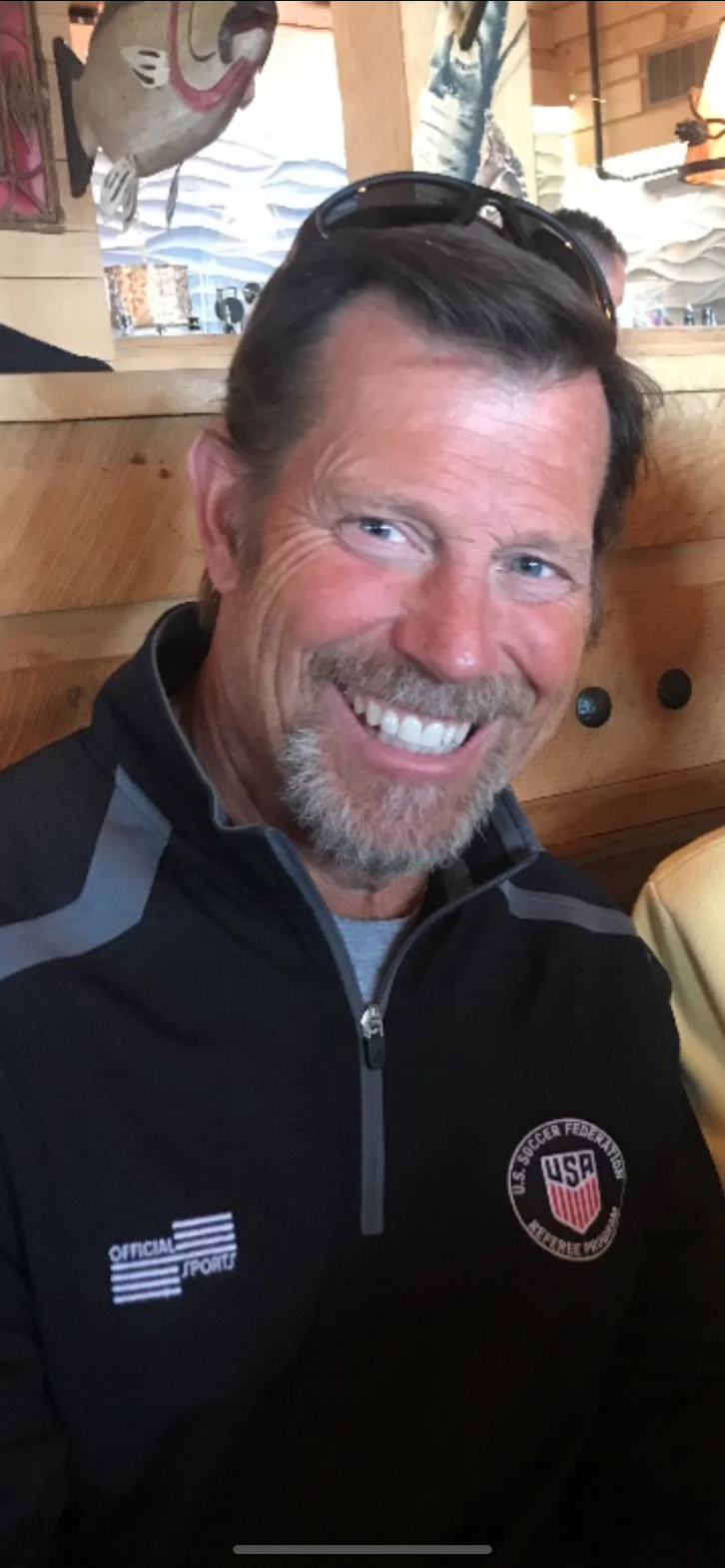
No Comments
Sorry, the comment form is closed at this time.